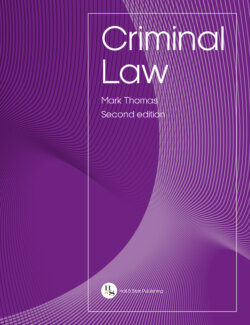Читать книгу Criminal Law - Mark Thomas - Страница 102
На сайте Литреса книга снята с продажи.
2.7.1Factual causation
ОглавлениеAlso known as ‘causation in fact’, this test requires the prosecution to establish that the consequence or end result would not have occurred as and when it did but for the defendant’s conduct. This test is known as the ‘but for’ test and is one of simple fact for the arbiters of fact. Essentially, where the consequence or end result would have happened anyway, despite the act or omission on the part of the defendant, there is no liability. We call this a causa sine qua non (often shortened to sine qua non) which essentially means ‘without which it could not be’. Simply, the defendant’s act or omission must have caused the end result. The classic example of factual causation in operation can be seen in R v White [1910] 2 KB 124.
case example
Charge: Murder
Case progression: Crown Court – Not guilty, but guilty of attempted murder
Court of Criminal Appeal – Conviction upheld
Point of law: The defendant must be the factual cause of the end result
In R v White [1910] 2 KB 124, the defendant attempted to poison his mother with potassium cyanide by placing the deadly substance in her lemonade. Whilst his mother did drink some of the liquid, she died having suffered from a heart attack. The medical evidence demonstrated that death resulted from the heart attack, and not from the poison. The defendant was charged with murder.
The Court of Criminal Appeal held that the defendant could not be liable for murder as there was not a sine qua non because his mother would have died anyway.
Note, however, that the son was convicted of attempted murder (see Chapter 5).
Contrast White with the case of R v Dyson [1908] 2 KB 454 in which the victim, a three-month-old child, would have likely died from meningitis. The defendant attacked the child and the Court of Criminal Appeal was satisfied that the defendant has accelerated the victim’s death. In this regard, the defendant was the factual cause of death as a result of his acts accelerating the child’s death.
Often, students struggle to grasp the concept of ‘but for’ and get lost in the wording. Suppose Jack wishes to kill Jill; Figure 2.4 will assist with this matter.
Figure 2.4Operation of factual causation
In many cases, factual causation will be obvious, eg Jack dies from being shot in the head by Jill. In this instance, Jill is clearly the factual cause of death, but that does not mean that the principle can be ignored or brushed over; it should still be explained in full (see R v Mitchell [1983] QB 741).
